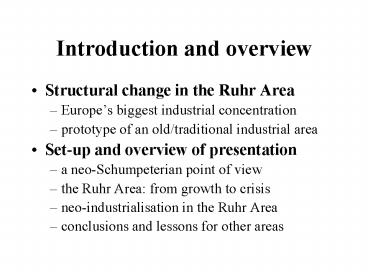Introduction and overview - PowerPoint PPT Presentation
1 / 8
Title:
Introduction and overview
Description:
Introduction and overview. Structural change in the Ruhr Area ... industrial conurbation in North-Rhine Westphalia. 5.5 million people on a surface of 4,400 km ... – PowerPoint PPT presentation
Number of Views:21
Avg rating:3.0/5.0
Title: Introduction and overview
1
Introduction and overview
- Structural change in the Ruhr Area
- Europes biggest industrial concentration
- prototype of an old/traditional industrial area
- Set-up and overview of presentation
- a neo-Schumpeterian point of view
- the Ruhr Area from growth to crisis
- neo-industrialisation in the Ruhr Area
- conclusions and lessons for other areas
2
A neo-Schumpeterian view
- Schumpeter growth is technology-driven
- new combinations as the economys engine
- Fourastié production effects of technology
- agriculture medium productivity growth
- manufacturing high productivity growth
- services low or zero productivity growth
- But simultaneously consumption effects
- saturation and rising demand for services
3
Towards new combinations
- Structural change to a services economy
- imbalance between production and consumption
- technology forces man to specialise in human work
- but time lag due to economic/institutional
lock-in - Neo-Schumpeterian view on industrial areas
- importance of an areas economic/institutional
past - issue how to connect manufacturing with
services? - new combinations of local traditions-global
trends
4
Growth of the Ruhr Area
- The Ruhr Area in the Blue Banana
- industrial conurbation in North-Rhine Westphalia
- 5.5 million people on a surface of 4,400 km²
- nicknames Smelztiegel, Ruhrstadt, Kohlenpott
- Work horse of the German economy
- coal and steel industry (Krupp, Thyssen,
Kirdorff) - rapid industrial growth during World War II
- 1950s from Ruhrstatut to Wirtschaftswunder
5
Severe industrial crisis
- Coal and steel crisis in the Ruhr Area
- since 1957 coal crisis (Zechensterben)
- since 1973 steel crisis (closure premiums)
- causes strong competition and overcapacity
- Bad starting position due to Altlasten
- economic rigid mono-structure and lock-in
- ecological pollution, e.g. in Emscher-river
- spatial urban patchwork without real centres
6
Towards neo-industrialisation
- The need for regional structural change
- since the 1960s regional policy (KVR)
- closures and technology policy (universities)
- opposition from local firms (Bodensperre)
- Since the 1980s a gradual policy change
- KVR ruhrgebietsfremde activities mainly fail
- neo-industrialisation combination of old with
new - revitalisation, diversification and regional
branding
7
Structural change in the 90s
- IBA Emscherpark programme (1989-1999)
- goal workshop for the future of industrial
regions - contents projects, e.g. revitalisation business
sites - process local empowerment (localisation)
- Neo-industrialisation in services economy
- integral approach to economy, ecology and space
- environmental, energy and solar tech on old sites
- industrial culture tourism, concerts, Ruhr Tour
8
Lessons for industrial areas
- Conclusion mixed feelings on Ruhr Area
- regional branding is good, but conceals problems
- new combinations do not offer many jobs
- risk festivalisation rather than revitalisation
- Lessons from the Ruhr Area for other areas
- neo-industrialisation coal and steel ? heavy
metal - localisation value of local cooperation from
below - diversification strive for many new
combinations































